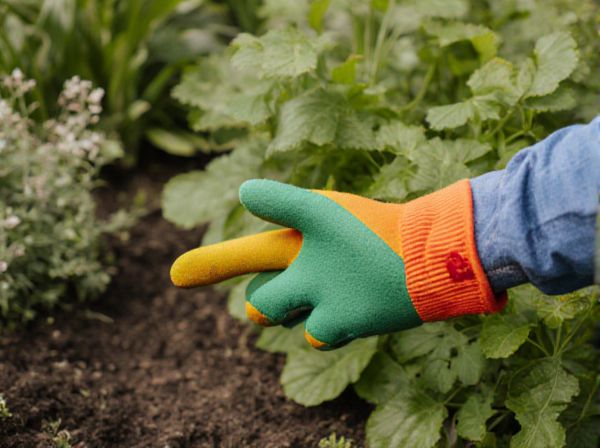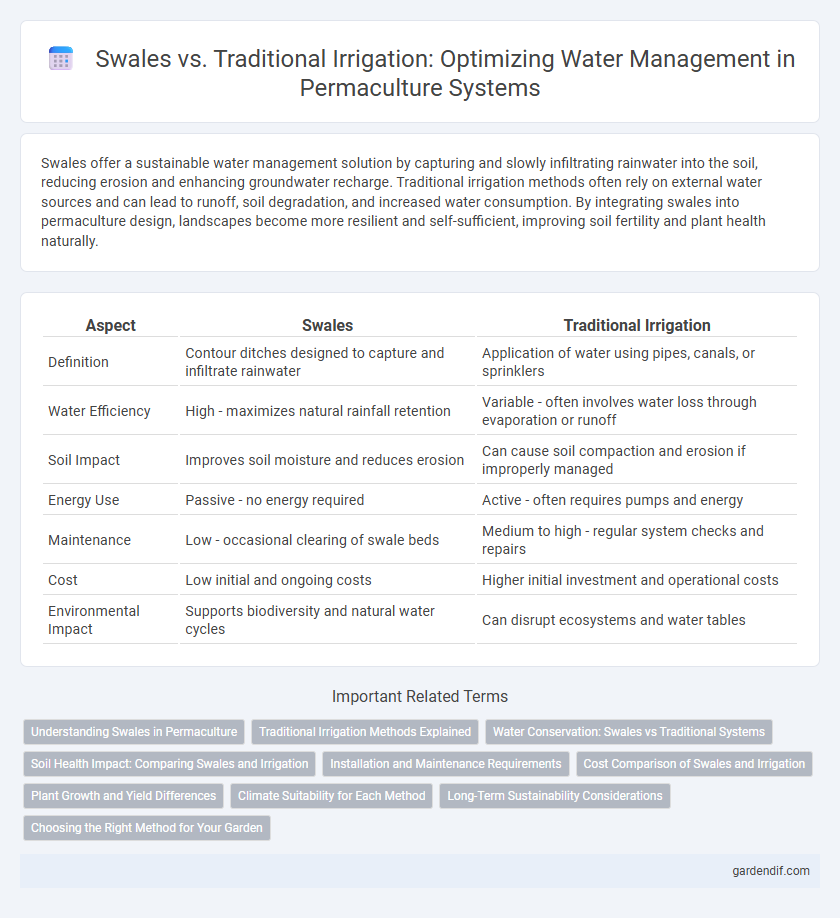
Swales vs traditional irrigation Illustration
Swales offer a sustainable water management solution by capturing and slowly infiltrating rainwater into the soil, reducing erosion and enhancing groundwater recharge. Traditional irrigation methods often rely on external water sources and can lead to runoff, soil degradation, and increased water consumption. By integrating swales into permaculture design, landscapes become more resilient and self-sufficient, improving soil fertility and plant health naturally.
Table of Comparison
| Aspect | Swales | Traditional Irrigation |
|---|---|---|
| Definition | Contour ditches designed to capture and infiltrate rainwater | Application of water using pipes, canals, or sprinklers |
| Water Efficiency | High - maximizes natural rainfall retention | Variable - often involves water loss through evaporation or runoff |
| Soil Impact | Improves soil moisture and reduces erosion | Can cause soil compaction and erosion if improperly managed |
| Energy Use | Passive - no energy required | Active - often requires pumps and energy |
| Maintenance | Low - occasional clearing of swale beds | Medium to high - regular system checks and repairs |
| Cost | Low initial and ongoing costs | Higher initial investment and operational costs |
| Environmental Impact | Supports biodiversity and natural water cycles | Can disrupt ecosystems and water tables |
Understanding Swales in Permaculture
Swales in permaculture are shallow, contour-based trenches designed to capture and infiltrate rainwater, reducing runoff and enhancing soil moisture retention. Unlike traditional irrigation systems that rely on external water sources and often cause water loss through evaporation or runoff, swales utilize natural landscape features to promote sustainable water management. These earthworks improve groundwater recharge and support resilient ecosystems by creating microclimates favorable for plant growth.
Traditional Irrigation Methods Explained
Traditional irrigation methods, such as flood irrigation and furrow irrigation, rely heavily on the controlled application of water through channels or ditches to deliver water directly to crops. These methods often result in significant water loss due to evaporation and runoff, making them less efficient in water-scarce regions. In comparison, swales in permaculture harness natural land contours to capture and infiltrate water, reducing erosion and promoting soil moisture retention.
Water Conservation: Swales vs Traditional Systems
Swales significantly improve water conservation by capturing and slowly infiltrating rainwater into the soil, reducing runoff and erosion compared to traditional irrigation methods that often lead to water loss through evaporation and surface runoff. This passive water management technique enhances groundwater recharge and sustains soil moisture for longer periods, supporting healthier plant growth without the need for frequent watering. Traditional irrigation systems typically require more water input and energy, making swales a more sustainable and efficient choice for permaculture water management.
Soil Health Impact: Comparing Swales and Irrigation
Swales enhance soil health by promoting water infiltration and reducing erosion, thereby increasing microbial activity and organic matter retention. Traditional irrigation often leads to surface runoff and soil compaction, which can degrade soil structure and reduce nutrient availability. By capturing and slowly releasing water, swales support a more resilient and fertile soil ecosystem compared to conventional irrigation methods.
Installation and Maintenance Requirements
Swales require careful contour mapping and excavation to ensure effective water capture and infiltration, which can result in higher initial installation efforts compared to traditional irrigation systems that rely on straightforward pipe and sprinkler setups. Maintenance of swales primarily involves periodic clearing of debris and managing vegetation to maintain water flow, whereas traditional irrigation demands regular inspection of pumps, pipes, and sprinklers to prevent leaks and clogs. Both systems offer sustainability benefits, but swales emphasize passive water retention with lower energy inputs, while traditional irrigation depends on consistent mechanical operation and water delivery.
Cost Comparison of Swales and Irrigation
Swales typically incur lower long-term costs than traditional irrigation systems due to minimal infrastructure needs and reduced water consumption. Traditional irrigation requires ongoing expenses for pumps, pipes, and water bills, which can sharply increase operational costs. By harnessing natural water flow and infiltration, swales provide an economical and sustainable alternative for water management in permaculture design.
Plant Growth and Yield Differences
Swales enhance water infiltration and soil moisture retention, promoting deeper root growth and higher plant yields compared to traditional irrigation methods that often cause surface runoff and uneven water distribution. By capturing rainwater and reducing erosion, swales create more resilient growing conditions with improved nutrient availability, directly boosting crop productivity. In contrast, traditional irrigation can lead to water stress during dry periods, limiting plant growth and reducing overall harvest volume.
Climate Suitability for Each Method
Swales excel in arid and semi-arid climates by capturing and infiltrating rainwater, reducing erosion and promoting groundwater recharge, making them ideal for sustainable water management in drought-prone regions. Traditional irrigation systems suit wetter climates or areas with reliable water sources, efficiently delivering water directly to crops but often leading to runoff and water waste in dry conditions. Understanding local rainfall patterns and soil permeability is crucial to selecting the optimal method for maximizing water efficiency and ecosystem health in permaculture designs.
Long-Term Sustainability Considerations
Swales enhance long-term sustainability by promoting natural water infiltration, reducing soil erosion, and replenishing groundwater compared to traditional irrigation methods that often rely on external water sources and can cause runoff and nutrient depletion. By capturing and slowly distributing rainwater along contour lines, swales support plant health and biodiversity with minimal energy input. Traditional irrigation systems typically consume more water and energy, increasing environmental impact and operational costs over time.
Choosing the Right Method for Your Garden
Swales offer a sustainable water management solution by capturing and slowly infiltrating rainwater, reducing runoff and erosion, which benefits permaculture gardens by maintaining soil moisture naturally. Traditional irrigation methods provide precise water delivery but often lead to higher water use and can cause soil degradation over time. Selecting the optimal method depends on soil type, local climate, and garden scale, with swales best suited for larger landscapes prioritizing long-term ecosystem health.
Swales vs traditional irrigation Infographic

 gardendif.com
gardendif.com